Text
Doing a rare signal boost, since I know @kaijutegu IRL and can vouch that this is real and necessary. Posted originally and reblogged on 4/25, so the need for an emergency foster starts 4/26. Chicago folk, please let her know if you’d be able to help.
Posting due to an emergency- please share widely if you're local to Chicagoland.
If anyone in the Chicagoland area sees this, a friend's service dog prospect is in need of immediate boarding from tomorrow until May 6. Winnie is about 40 pounds and is not dog-reactive at all, but the person caring for her was hospitalized and so my buddy is looking for a short term emergency foster!
I'm available to help with any transportation (you wouldn't need to drive her anywhere!) and compensation+coverage for food/medical/etc. would be involved. You wouldn't need to pay for her stuff, just make sure she has a place to stay and walk her and call me if she needs to go to the vet.
If this is something you or someone you know could help with, please let me know. It's an emergency situation, so for the first time in... well over a year, I am opening my inbox in case this is something you can help with. Please DM me if you or anyone you know can help.
744 notes
·
View notes
Note
If you don’t mind sharing, since you don’t work for a zoo what is your job situation like? Making a living while working at a definitely zoo seems tricky. Is your main income zoology/animal related or is that more of a side thing?
Sincerely,
- a curious zoology student
I have a (mostly) unrelated jobjob - I’ve never actually been affiliated with a single facility, unless you count college internships before I started this blog. I freelance, working as a science media fact-checker and taking paid research contracts occasionally. I do work on a lot of animal / biology related fact-check content, but it’s not my entire scope of work. I also have the privilege of having family assistance, as I have chronic health issues that interfere with the normative 9-5 grind.
Everything I do in terms of blog writing/research, zoo industry research and publication, and photography is unpaid and pretty much a hobby at this point.
Prior to the pandemic I was trying to find funding for the intra-industry research and public-facing outreach I was doing, but there was never any money for it. (The industry is very used to expecting labor from young women for free. There was and is a lot of interest in the work I do, but the number of people/orgs that have ever provided compensation or financial support is in the single digits). The pandemic actually gave me the chance to pivot to focusing on professional fact-checking.
The only funding I get for any of this work is through a somewhat defunct Patreon I set up years ago when I was trying to make this blog / scicomm a full time gig. I’m terrible at updating it, and I’m conflicted enough about that to have been considering deleting it entirely. (For those of you who have stuck it out despite the radio silence, you’re incredible. You’ve facilitated the donation of my time to write a really cool paper with a zoo disaster response org, which will hopefully get through peer review soon).
To make something like this blog and everything else I do in the field actually financially sustainable, I’d need to fundraise and market more. The thing about a fact-checking career, though, is that it’s reinforced the need to make sure everything I write/say publicly is completely and 100% correct - because that level of rigor is what supports my professional reputation! Which means I’m slow to produce research and reticent to talk about it before it’s finished. My work comes out all the better for it, but it doesn’t fit into a content model that produces revenue.
So yeah, all of this is a side thing that I fit in around my paid work and my health. Because sometimes I just need to go see a tiger and smell an elephant, y’know?
#personal information#zoo job almost always require multiple incomes or family support#or generational wealth#otherwise you live in poverty#I am on a very non traditional industry path and it definitely does not pay either#but it’s a passion project
131 notes
·
View notes
Note
Woodland Park Zoo has a program to supply its herbivores with different kinds of plant browse that's grown on-site-in addition to more traditional vegetable produce-which is stashed fresh daily in different areas of their enclosures to encourage foraging behaviors. I was curious if you had any thoughts or even found it notable
It isn’t really notable, but that’s a good thing! It means lots of zoos are using it to enrich their animals’ lives. Browse is really important enrichment for herbivores because so much I’d their normal activity budget is dedicated to finding and eating food - and it’s generally low enough calorie that they don’t need to be limited on how much they can have.
Some facilities even take donations of browse from local communities when trees are trimmed or cut down! After very carefully vetting them for pesticides or other health risks, of course.
97 notes
·
View notes
Note
I forget what zoo you work for, but I had the pleasure of visiting the Oakland Park zoo with my friends the other day, and it was in part thanks to you! We were originally going to go to the SF Zoo, since it was closer and we didn't know any better, but, remembering all your posts about AZA accreditation got me to look more deeply into both the SF and Oakland zoos, and we decided to switch to the Oakland Zoo instead! Which, according to everyone we've talked to, is apparently the significantly superior experience, and I'd believe it!
I don’t work for any zoo, actually (combination of wanting to think outside the box, disability, and the fact basically none of them pay a living wage). But thank you!
Oakland and San Francisco are drastically different experiences, but from a guest perspective personally I haven’t felt like one is better than other. (Although man. SF just had some major drama drop that calls a lot of management into question, I should write that up soon).
I’m glad you enjoyed your visit!
65 notes
·
View notes
Text
He apparently lost it due to injury when he was very little. I can’t find more details from either WPZ or the Audubon Zoo, where he was born.
The Woodland Park Zoo had a spring event this past weekend, which I had to hit up for the fun enrichment. My favorite of all is the maned wolves - who you rarely ever get such a good chance to see!
One moment, they're elegant and ethereal. Then there's enrichment, and you realize they're just long-legged stinky goofballs [affectionate].
Meet Rosario (with tail) and Urso (tail-less).
Elegant, ethereal, unreal:
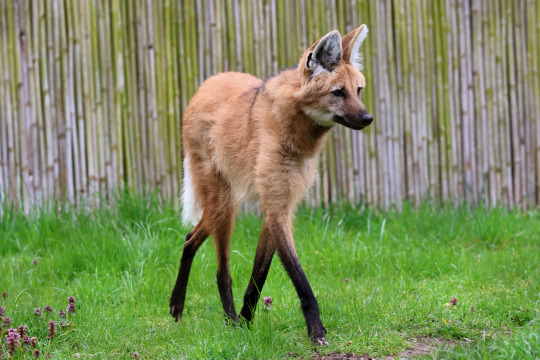

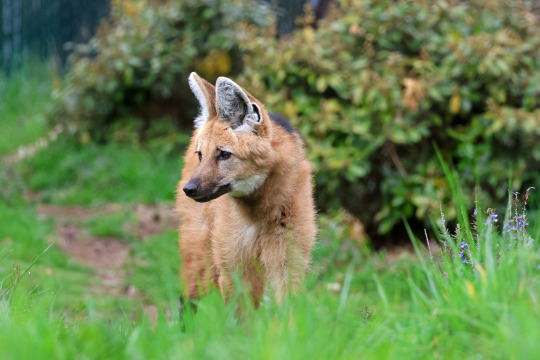


Ridiculous, adorable, dogs-running-fox-software:

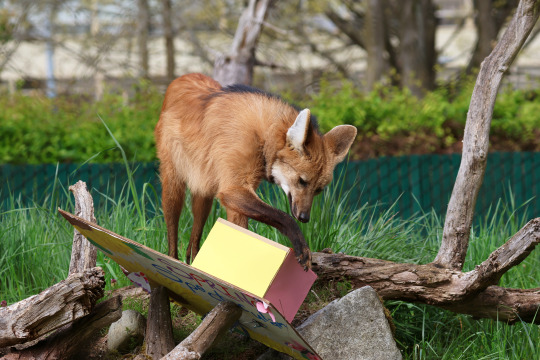

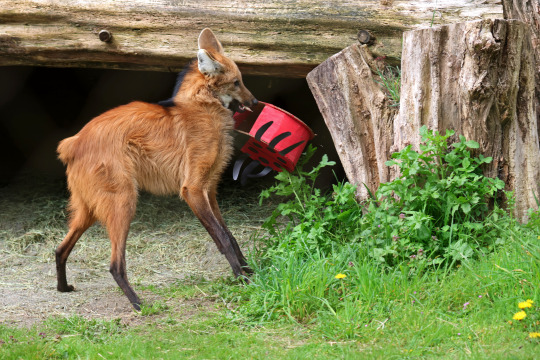

2K notes
·
View notes
Note
The boys are back together!!
Lincoln Park posted the photos below along with this update on April 23:
"After successful reintroductions to Pesho, Sidai and Pilipili in their indoor space, Lomelok’s care and veterinary teams have made the decision to allow intermittent yard access for all four youngsters starting today.
Lomelok will continue to need rest days as he builds his endurance, so you will not always see the coalition of boys outside as his brothers may stay with him indoors as company. The animal care and veterinary teams will continue to monitor his progress as he continues on his journey."
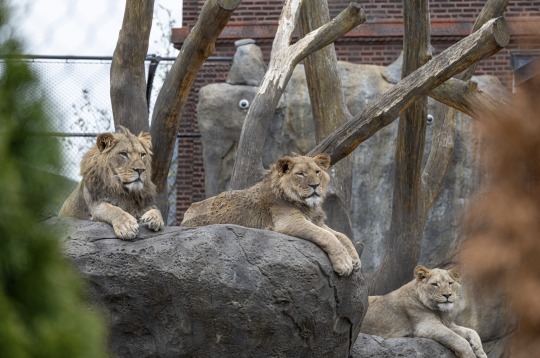
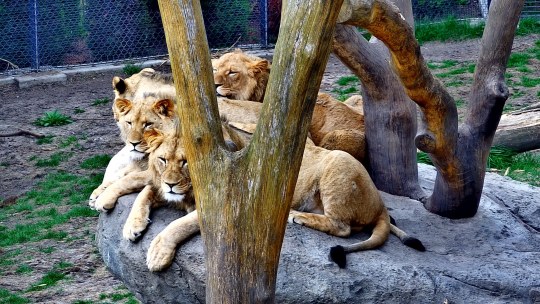
Here's a great article about Lomelok's unprecedented spinal surgery, the reintroductions to his brothers, and the physical therapy routine the zoo has set up for him.
My heart melted seeing the Lincoln Park zoo pride, the cubs are yearlings and already getting big, they grow up so fast😭. Lomelok just went through surgery yesterday to correct a slipped spinal disc. Plz send good vibes to Chicago!
I think Lomelok is a testament to how excellent veterinary care is for zoo animals, in the wild he probably would’ve died before his first birthday as he started showing experiencing weakness in his hind legs and tired easily as a tiny cub. Just wanted to share.
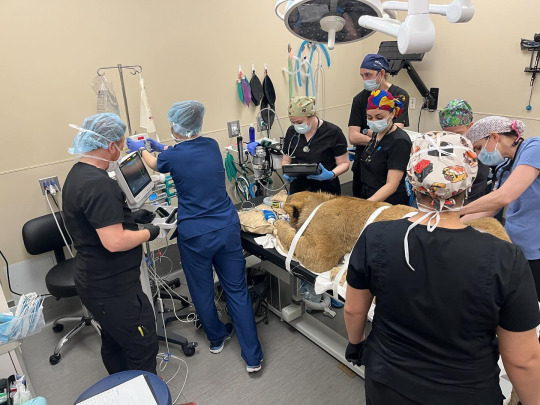
According to the zoo yesterday, he's out of surgery and doing well!
"The update we’ve all been waiting for with bated breath. Last night, around midnight, Lomelok fully stood up on his own for the first time! This is a huge milestone for his recovery but is one of the first literal and figurative steps in his journey. Afterward, he took a long 5-hour nap as the care team observed from nearby via camera so he could rest undisturbed.
Lomelok is currently recovering in a small space that controls the level of his activity during these critical first 72 hours."
#love these awkward adolescent manes#lions#lion cubs#lincoln park zoo#zoo animals#big cats#injury mention#surgery mention
1K notes
·
View notes
Text
Animal reference photo compilation concept test!
I've been saving this project for a new website I'm planning, but that's been delayed by the grindstone of capitalism, so I'm going to set up this part early. This is the concept test for a repository of reference photos of a whole bunch of different species of exotic animals.
For every 50 or so photos I take of an animal, there's generally only a couple that I like and are also in focus and also framed correctly. But that led me to realize... all those slightly blurry or off-center photos are probably a great set of references for people interested in general shape/form/movement for their art! So I'm setting up of the idea before fully committing the time into making it happen.
I've been going through my photo backlog and pulling out the shots I think will be useful for art references. Lots of them show posture, facial movement, close-ups of feet or eyes, and walk cycles, but also other behaviors like jumping or drinking. They're not perfect - there's often stuff out of focus or reflections on the glass - but I think they'll still be useful for art?
The link below is to the Dropbox where I'll host these photos until I eventually get that new website/project up and running. Right now I've got folders of four species uploaded for this test: California Condor (CW for carcass feed photos), Jaguar, Komodo Dragon, and Moose. Please go check them out and tell me what you think!
~~WADTT Animal Reference Photos Dropbox Link~~

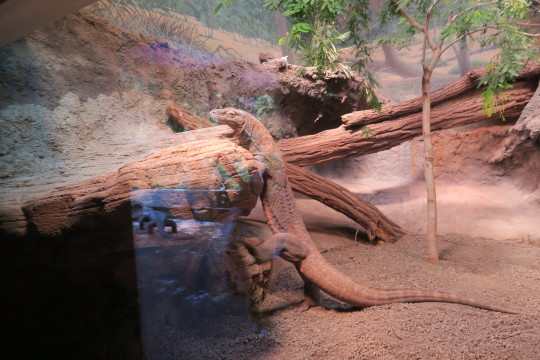
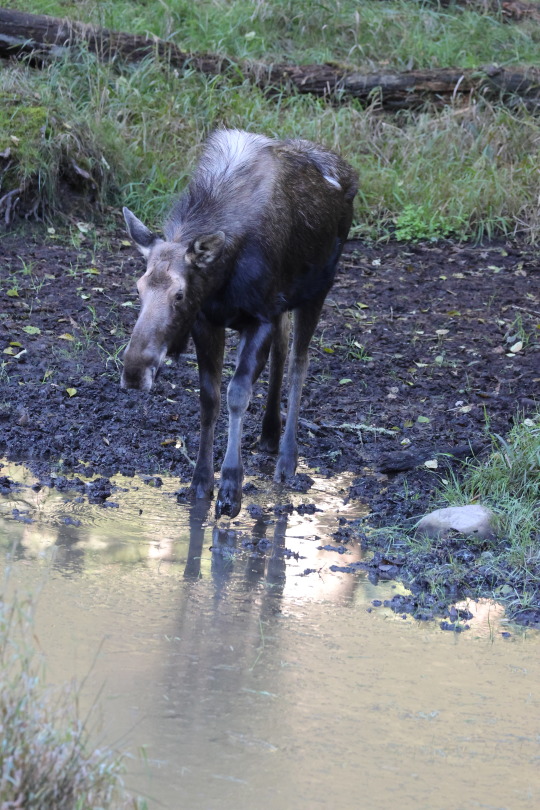
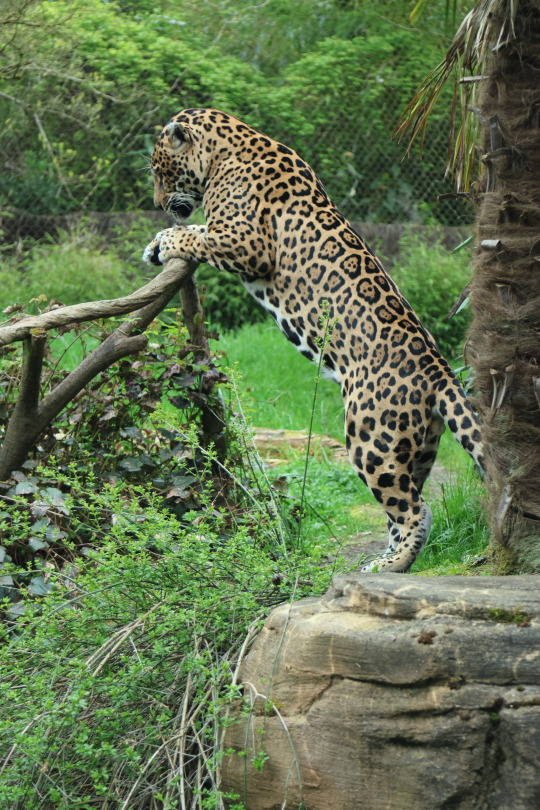
What I'm looking to learn from y'all is:
Is this type of reference photo repository useful / worth doing?
Do these photos work or are they too blurry/wonky/there's too many?
What things would make a project like this better? (Caveat, it has to stay on Dropbox for now).
If this turns out to be as useful as I'm hoping, and the photos work, I've got a whole bunch more species to upload.
#zoo photos#art reference#art references#animal photos#drawing reference#this is a test#my photography#zoo photography#feedback requested please#if you use these please tag me in the final art so I can see what they created
589 notes
·
View notes
Text
The Woodland Park Zoo had a spring event this past weekend, which I had to hit up for the fun enrichment. My favorite of all is the maned wolves - who you rarely ever get such a good chance to see!
One moment, they're elegant and ethereal. Then there's enrichment, and you realize they're just long-legged stinky goofballs [affectionate].
Meet Rosario (with tail) and Urso (tail-less).
Elegant, ethereal, unreal:





Ridiculous, adorable, dogs-running-fox-software:





2K notes
·
View notes
Text
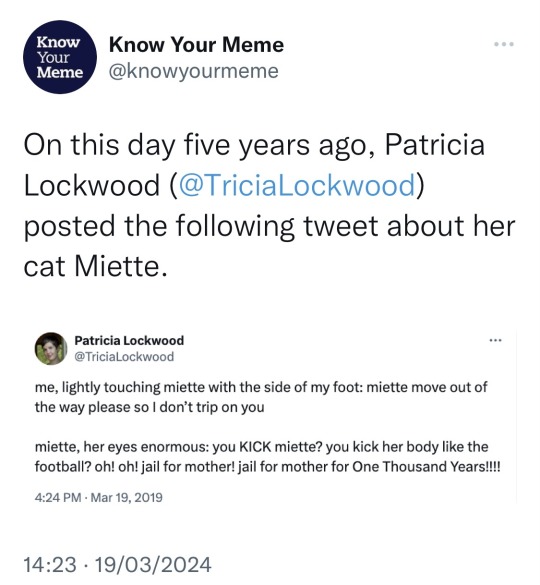
5 year anniversary of the miette post \o/
74K notes
·
View notes
Text
One of the most common question types this blog gets is some flavor of asking if Weird Games are okay. The people writing in are always very concerned for their pet’s safety and welfare (which I applaud) and often looking for an explanation of the behavior (which I have zero ability to give). This speaks to how common it is for cats - and other pets - to enjoy Weird Games.
This video is a great example of the best way to tell if a Weird Game is a thing your animal actually likes: let them initiate! The cat is being carried in a weird way when the video starts, but then immediately runs back to the designated “game spot” and asks for it to happen again. If you’re not sure if an animal likes an interaction - be it petting or a Weird Game - just stop, and see if they actively re-engage. If yes, you’re good to go!
Obviously, physical safety is an aspect of Weird Games too. The cat in this video apparently likes being carried upside down, which could injure it if it happened too much. But what we see is that their person supports the cat very securely, moves slowly, doesn’t go very far, puts the cat down on a soft and easy to reach surface, and doesn’t let the Game go on for too long. The cat also isn’t being held tightly and could clearly get free / ask to be put down if it became uncomfortable or wanted to be done. That seems like a good way to make that Weird Game safe to me (vets, please feel free to correct me here). If you’re worried about if a Weird Game is safe, ask your vet! You’ll make their day and get some useful information.
37K notes
·
View notes
Text
Do you have a snoot noodle or other variation of sighthound? If yes, there’s new heart health research for the breed happening!
A researcher at Texas A&M whose work I’m familiar with is starting a new study looking at genetic factors contributing to heart disease in Borzoi and related breeds. They just put out a call for dog owners who are willing to submit saliva samples & (noodle) medical records. Studies like this need a big sample size! They’re accepting new sign-ups starting now until March 1, 2025, for dogs both in the US and internationally.
Let’s help make some science!
From the study page:
“Background and purpose
Recent research in Borzoi dogs has revealed that dogs of this breed experience sudden, unexplained death. About 85% of sudden, unexplained deaths in humans are linked to an underlying heart disease. Our existing research in Borzoi dogs has shown that they are predisposed to developing arrhythmias (abnormal heart rhythms) and dilated cardiomyopathy (a heart muscle disease causing dilated heart chambers and weak pumping function).
Due to our documentation of the frequency of these conditions in Borzoi dogs, we seek to identify responsible genetic variations similar to what is seen in humans with electrical cardiac diseases that trigger arrhythmias and dilated cardiomyopathy.
The objective of our study is to identify genetic mutations associated with heart disease in Borzoi dogs and document their existence in other sighthound breeds.
What happens in this study
We are collecting saliva samples from both healthy Borzoi and Borzoi dogs affected with arrhythmias and/or dilated cardiomyopathy. We will also collect saliva samples from any other sighthound breeds.
We will extract DNA from these samples and perform genomic sequencing on a select number while retaining the remainder for further screening.By analyzing the sequencing data, we can compare the genes of healthy and affected Borzoi dogs and identify variants linked to their heart conditions. We will also compare the findings in Borzoi dogs to results from other sighthound breeds.
Pet owner responsibilities
A swab kit will be sent to you for at home use along with a link to an instructional video on how to properly obtain a swab of the mouth. The kit will contain equipment to collect the saliva swab, a history form for your pet, a client consent form and a shipping label to return samples to us.
Participation requirements
To participate, you must have a Borzoi dog or a sighthound breed that is either healthy or affected by arrhythmias and/or dilated cardiomyopathy. Pets may be any age or sex. Electronic or paper veterinary medical records will need to be provided.
Benefits and risks of participating
There is little to no risk for taking a brief swab of the mouth for saliva collection if procedures outlined in the video are followed. No individual genetic test results will be provided to study participants.
Compensation
There is no cost to the owner for participating in this study. No compensation will be provided.”
#I know this lab from big cat genetics#but they do good work on lots of things#sighthound#borzoi#silken windhound#greyhound#afghan hound#ongoing research#citizen science contributions#contribute to science
2K notes
·
View notes
Text
Over the last few years, I’ve begun to heavily encourage people to think of a zoo or aquarium or sanctuary being accredited as conveying important information about their ethos / operations / politics - but not as an inherent indicator of quality. Why? Because accrediting groups can be and are fallible. There are issues with all of the accrediting groups and programs, to varying degrees, and so they’re just a piece of information for a discerning zoo-goer to incorporate into their overall opinion. I just saw a news article go by with some data that proves my point.

First off, good for Houston, no commentary that follows is directed that them.
This isn’t the first time I’ve seen a headline like this - there was one a couple years ago, about Cheyenne Mountain Zoo in Colorado also getting a perfect inspection. But here’s what bugs me about it.
If you see/hear the phrase “Facility X has been accredited by Y organization, which holds the highest standards in the world for this type of facility”, it kind of implies that facility X meets all of those standards, doesn’t it? Not most of them, not the majority. When you hear that a zoological facility has gone through a rigorous process to earn an accreditation branded (by the accrediting org) as “the gold standard” in the industry… the general public is going to interpret that as saying these facilities are in compliance with every single rule or standard. And what these headlines tell us, alongside the commentary from AZA in the articles, is that it’s not only not true - it never has been true. Most AZA accredited facilities apparently don’t meet all the AZA standards when they’re inspected, and that’s both okay with them and normal enough to talk about without worrying about the optics.
Let’s start with the basic information in the Houston Chronicle article, which will have been provided to them by the zoo and the AZA.
“Since it's inception in 1974, the AZA has conducted more than 2,700 inspections and awarded only eight perfect evaluations throughout the process's 50-year history. Houston Zoo's final report is 26 pages long — and filled with A's and A-pluses."
Okay, so… doing that math, less than one percent of AZA accreditation inspections don’t meet all the standards at the time of inspection. But, wait, that’s not just what that says. That bit of information isn’t talk about AZA accredited facilities vs the ones that got denied accreditation: this is telling us that of facilities that earned AZA accreditation, basically none of them meet all the standards at the time. This isn’t talking about tabled accreditations or provisional ones where they come back and check that something improved. Given that math from earlier, this information means that most - if not all - AZA accredited facilities have repeatedly failed to meet all of the standards at one point in time … and have still been accredited anyway.
That tracks with what was said about Cheyenne Mountain Zoo, back in 2021 when they got their perfect accreditation.
“Cheyenne Mountain Zoo has earned an incredibly rare clean report of inspection and its seventh consecutive five-year accreditation from the Association of Zoos and Aquariums (AZA). In nearly 50 years of accreditations, CMZoo is only the fourth organization to earn a ‘clean’ report, which means there wasn’t a single major or minor concern reported”
Seven consecutive accreditation processes - and only one of them where they actually met all the standard at the time.
Here’s what the AZA CEO had to say about Houston’s accreditation achievement in that article, which reinforces my conclusion here:
"AZA president and CEO Dan Ashe says the multi-day inspection process, which occurs every five years, has been described as "comprehensive, exhausting and intimidating."
"We send a team of experts in who spend several days talking to employees, guests and the governing board. They look at animal care and husbandry. They look at the governance structure and finances. They look comprehensively at the organization," Ashe explains. "For a facility like Houston Zoo to have a completely clean accreditation and inspection is extremely rare. These inspectors are experts, it's hard to get to the point where they can't find something.""
Now, here’s the rub. We, as members of the public, will never have any idea which standards it is deemed okay for a given AZA facility to not meet. All of the zoological accrediting groups consider accreditation information proprietary - the only way we find out information about how a facility does during accreditation is if they choose to share it themselves.
On top of that, it’s complicated by the fact that last time I read them AZA had over 212 pages of accreditation standards and related guidance that facilities had to comply with. Now, AZA doesn’t accredit facilities if there are major deviations from their standards, or if there’s an issue on something important or highly contentious. So - based on my completely outsider but heavily researched perspective - this probably means that most zoos are in non-compliance with a couple of standards, but not more than a handful.
To make trying to figure this out even more fun, it is also important to know that AZA’s standards are performance standards: whether or not they’re “met” is based on a subjective assessment performed by the accreditation inspectors and the accreditation committee. This means that what qualifies as fulfilling the standards can and does vary between facilities, depending on who inspected them and the composition of the committee at the time.
So why do I care so much? Because when it comes to public trust, branding matters. AZA has gained a reputation as the most stringent accrediting group in the country - to the point that it can lobby legislators to write exceptions into state and federal laws just for its members - based on how they message about their accreditation program. How intensive it is, how much oversight it provides, what a high level of rigor the facilities are held to. That… doesn’t track with “well, actually, the vast majority of the zoos meet most of the standards most of the time.” People who support AZA - people who visit AZA accredited zoos specifically because of what it means about the quality of the facility - believe that accreditation means all the standards are being met!
To be clear: most AZA zoos do meet some pretty high standards. It’s likely that what are being let slide are pretty minor things. I expect it’s on stuff the facility can improve without too much hassle, and it might be that doing so is probably part of what’s required. There’s not enough information available to people outside the fold. But I will say, I don’t think any zoo is getting accredited despite AZA having knowledge of a serious problem.
Where I take issue with this whole situations is the ethics of the marketing and branding. AZA frames themselves as being the best-of-the-best, the gold standard, when it turns out that most of their accredited zoos aren’t totally in compliance, and they know and it’s fine. They seem to be approaching accreditation like a grade, where anything over a certain amount of compliance is acceptable. The public, though, is being fed a narrative that implies it’s a 99/100 pass/fail type of situation. That’s not super honest, imho, which shows up in how there’s zero transparency with the public about it - it goes unspoken and unacknowledged, except when it’s used for promotional gain.
And then, like, on top of the honesty in marketing part, it’s just… something that gets joked about, which really rubs me the wrong way. Like this statement from the media releases for the Cheyenne Mountain accreditation:
“Another of our ‘We Believe’ statements is, ‘We value laughter as good medicine,’” said Chastain. “To put this clean accreditation into perspective, when I asked Dan Ashe, AZA president and CEO, for his comments about how rare this is, he joked, ‘A completely clean inspection report is so unusual, and so unlikely, it brings one word to mind — bribery!’“
So, TL;DR, even AZA accreditation is designed so that their accredited zoos don’t have to - and mostly don’t - actually fully meet all the standards. I’d love to know more about what types of standards AZA is willing to let slide when they accredit a facility, but given the proprietary nature of that information, it’s pretty unlikely there will ever be more information available. AZA accreditation tells you what standards a zoo aspires to meet, what their approximate ethics are, and what political pool they play in. When it comes to the quality of a facility and their animal care, though, sporting an accreditation acronym is just a piece of the larger puzzle.
#AZA accreditation#zoo accreditation#zoo politics#my research#There’s a lot more nuance to how accreditation inspections work and how facilities with bigger issues are given changes to correct them#but that’s for another post#right now I’m just irked that it is so normative for AZA facilities to get accredited without clean inspections
464 notes
·
View notes
Text
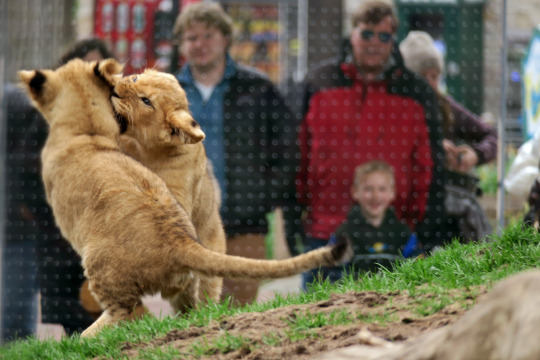
'Boop someone' day?
You obviously mean 'BITE someone' day.
Feat. the Lincoln Park Zoo lion littles, last spring.
616 notes
·
View notes
Text
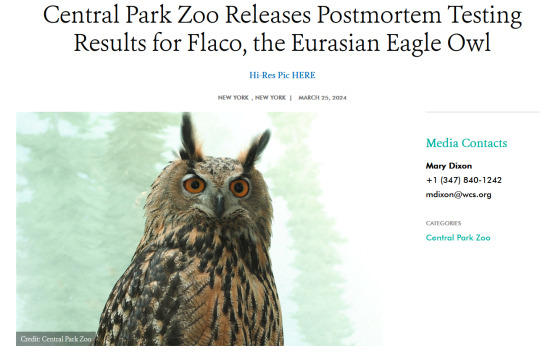
The Bronx Zoo has just released Flaco's necropsy results.
He was not thriving, as the people championing the ideal of "freedom" claimed.
He was poisoned.
He was sick.
He was suffering.
"Freedom" would have eventually killed him. A building just happened to do it first.
"Postmortem testing has been completed for Flaco, the Eurasian eagle owl that was found down in the courtyard of a Manhattan building a little over a year after his enclosure at the Central Park Zoo was vandalized on February 2, 2023. Onlookers reported that Flaco had flown into a building on the Upper West Side of Manhattan on February 23, 2024, and acute trauma was found at necropsy.
Bronx Zoo veterinary pathologists determined that in addition to the traumatic injuries, Flaco had two significant underlying conditions. He had a severe pigeon herpesvirus from eating feral pigeons that had become part of his diet, and exposure to four different anticoagulant rodenticides that are commonly used for rat control in New York City. These factors would have been debilitating and ultimately fatal, even without a traumatic injury, and may have predisposed him to flying into or falling from the building.
The identified herpesvirus can be carried by healthy pigeons but may cause fatal disease in birds of prey including owls infected by eating pigeons. This virus has been previously found in New York City pigeons and owls. In Flaco’s case, the viral infection caused severe tissue damage and inflammation in many organs, including the spleen, liver, gastrointestinal tract, bone marrow, and brain.
No other contributing factors were identified through the extensive testing that was performed.
Flaco’s severe illness and death are ultimately attributed to a combination of factors—infectious disease, toxin exposures, and traumatic injuries—that underscore the hazards faced by wild birds, especially in an urban setting."
The naturalistic fallacy kills animals in horrible ways. The romanticism of what humans want to think of as a "free, wild, pure life" cannot be allowed supplant the reality of injury, sickness, and death. Releasing captive animals (or keeping them from being recaptured) because it's "better" for them to suffer untethered than live a healthy, safe, captive life is inhumane and horrific.
Flaco's life didn't have to end in pain, sickness, and suffering.
Flaco's death didn't have to be tragic.
But once the idea of "freedom" entered the chat, Flaco's fate was unavoidable.
#flaco#tw animal death#tw animal sickness#better dead than fed is a horrific mindset#zoo animal welfare#screenshot feat the WCS's inability to remember to remove their editorial template from highly sensitive press releases round 2#colored text#people who loved the ideal of him more than the reality of him#congrats#you killed this owl#I'm still so mad that people who wanted him to stay loose got all sorts of media attention for the elegies they wrote when he died
7K notes
·
View notes
Note
Question relevant to Flaco-
It's my understanding that birds are generally able to see UV light, invisible to us. Do you think it would be feasible to create a mesh visible in UV, but not the human visible spectrum, that could be applied to windows and outer surfaces of buildings to reduce bird impacts? Not really concerned about the economic feasibility, just the functional.
This does exist!
UV stickers you can put on residential windows are pretty common these days (if you can access the outside of them - not so good for a Manhattan skyscraper).
I found a couple companies offering UV-reflective options for commercial buildings, in addition to some other visually deterrent options. Guardian BirdFirst UV is a coating, and GlasPro
Bird Safe UV looks to be a patterned UV layer inserted between the exterior layers of glass windows.
None of these are totally invisible to the human eye (especially if the surface is wet, for some reason) but they're fairly easy to ignore. Normally they look like stripes or little square dots in a repeating pattern.
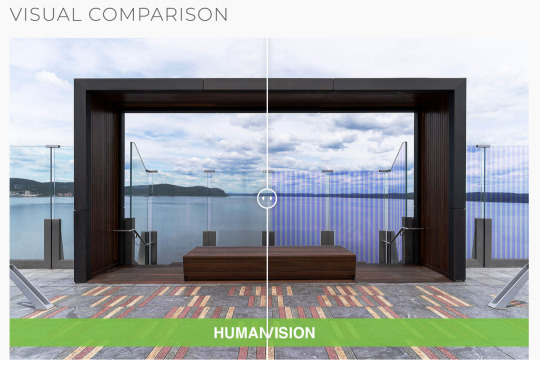
This is from the GlasPro site, human vision on the left, bird on the right.
It comes down to convincing people to use them: they have to believe it's important and be willing to put up with something not perfectly invisible that might be "unpleasing" or something. I also don't know how much these coatings cost, but I'd guess they're probably something only organizations that really care will want to shell out for.
402 notes
·
View notes
Text
I present to you: the aforementioned tiger shenanigans.

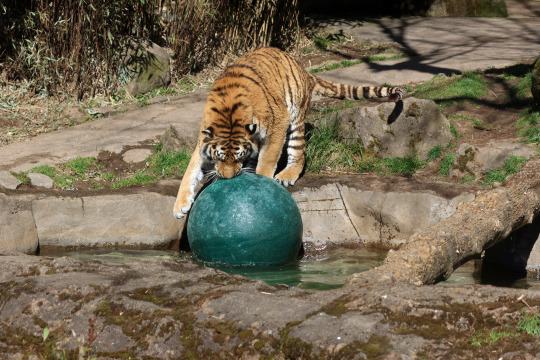


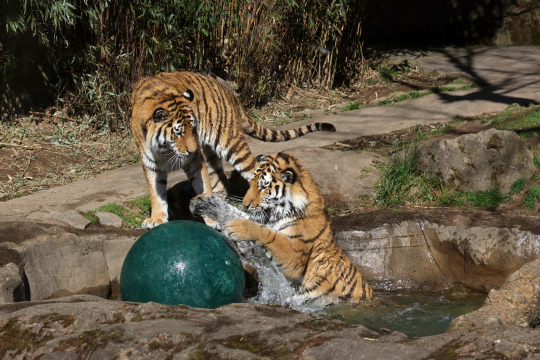
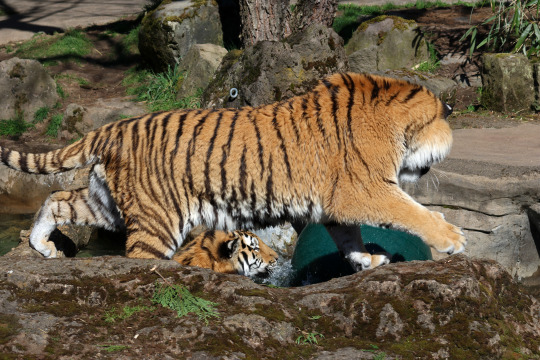
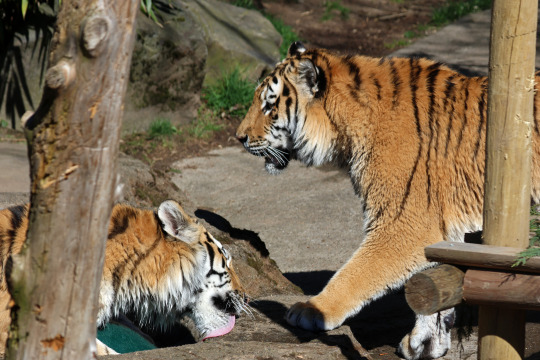
This is Amur tiger brothers Luka and Dmitri, who just turned two a few days ago! Two boys and their boomer ball.
1K notes
·
View notes
Text
I don’t need a third memory card for a zoo day, I said, 96GB is more than enough.
Then the second card ran out in the middle of tiger sibling shenanigans.
317 notes
·
View notes